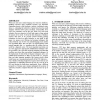Free Online Productivity Tools
i2Speak
i2Symbol
i2OCR
iTex2Img
iWeb2Print
iWeb2Shot
i2Type
iPdf2Split
iPdf2Merge
i2Bopomofo
i2Arabic
i2Style
i2Image
i2PDF
iLatex2Rtf
Sci2ools
IDEAS
2008
IEEE
2008
IEEE
Improved count suffix trees for natural language data
With more and more natural language text stored in databases, handling respective query predicates becomes very important. Optimizing queries with predicates includes (sub)string estimation, i.e., estimating the selectivity of query terms based on small summary statistics before query execution. Count Suffix Trees (CST) are commonly used to this end. While CST yield good estimates, they are expensive to build and require a large amount of memory to be stored. To fit in the data dictionary of database systems, they have to be severely pruned. Existing pruning techniques are based on suffix frequency or tree depth. In this paper, we propose new filtering and pruning techniques that reduce both the size of CST over natural-language texts and the cost of building them. The core idea is to exploit features of the natural language data, i.e., regarding only the suffixes that are useful in a linguistic sense. The most important innovations are (a) a new aggressive approximate syllabification...
| Added | 31 May 2010 |
| Updated | 31 May 2010 |
| Type | Conference |
| Year | 2008 |
| Where | IDEAS |
| Authors | Guido Sautter, Cristina Abba, Klemens Böhm |
Comments (0)

